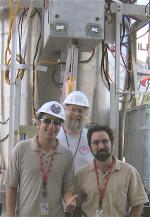- Home
- Classes
- Physics 150 – Nuclear Weapons – Physics, Policy, Proliferation – Fall 2025
- Physics 134 – Observational Astrophysics – Fall 2025
- Astro 1 Spring 2024
- INT 86TN Planetary Defense – Spring 2024
- Symmetry & Aesthetics in Contemporary Physics
- INT 184 – PL Interdisciplinary Honors Seminar – Weapons of Mass Destruction – Spring 2013
- Physics 150 – Modern Design and Fab – Fall 2019
- Physics 4 – Winter 2023
- Physics 141 – Optics – Spring 2019
- Physics 145L – Astrophysics Research
- Physics 199 – Independent Research
- Projects
- Interdisciplinary Center for Interstellar Exploration (iC)
- NASA Watts on the Moon
- Extrasolar Travelers
- CMB-S4 – Ground Based CMB Cosmology Program
- Wafer Scale Spacecraft
- PI-Multimodal Planetary Defense
- Lunar Rover Project
- DE-STAR
- Starlight
- GreenPol – CMB Cosmology
- PLANCK
- Starshot
- SETI
- Small Projects
- Previous Projects
- Facilities
- People
- Net
- Outreach
- Media Links
- NASA Space Grant Student Scholarships
- Bright Stars – VoH
- ARC – Undergraduate Aerospace Research Coop
- POINT – Undergraduate Physics Organization for Innovation and Technology
- All Sky Camera Project
- Education and Public Outreach
- Gaucho Rocket Project
- Undergrad Research Opportunities
- The Space Race
- Misc
- Papers
ARCADE latest results
 ARCADE – News
ARCADE – News
A team of NASA-funded scientists, including two from UC Santa Barbara, have discovered
cosmic radio noise that is completely unexpected.
The finding came from data collected from a large helium-filled NASA balloon, big enough to fit a football field inside. The scientists discovered cosmic radio noise that is blasting six times louder than expected.
Click for downloadable imageThe launch of the NASA ARCADE balloon. Click for downloadable image A diagram showing |
“It seems as though we live in a darkened room and every time we turn the lights on and explore, we find something new,” said team member Philip M. Lubin, professor of physics at UCSB. “The universe continues to amaze us and provide us with new mysteries. It is like a large puzzle that we are slowly given pieces to so that we can eventually see through the fog of our confusion.”
The findings will be presented today at the 213th meeting of the American Astronomical Society in Long Beach, Calif. The mission, named ARCADE, was to search the sky for heat from the first generation of stars. Instead, it found a cosmic puzzle.
A mysterious screen of extra-loud radio noise permeates the cosmos, preventing astronomers from observing heat from the first stars. The balloon-borne ARCADE instrument discovered this cosmic static on its July 2006 flight. The noise is six times louder than expected. Astronomers have no idea why.
“The universe really threw us a curve,” says team leader Alan Kogut team leader from NASA’s Goddard Space Flight Center. “Instead of the faint signal we hoped to find, here was this booming noise six times louder than anyone had predicted.” Detailed analysis ruled out an origin of primordial stars or known radio sources, including gas in the outermost halo of our own galaxy. The source of this cosmic radio background remains a mystery.
ARCADE stands for the Absolute Radiometer for Cosmology, Astrophysics, and Diffuse Emission. The instrument launched from NASA’s Columbia Scientific Balloon Facility in Palestine, Tex., and flew to an altitude of 120,000 feet, where the atmosphere thins into the vacuum of space.
The problem, notes team member Dale Fixsen of the University of Maryland, is that there don’t appear to be enough radio galaxies to account for the signal ARCADE detected. “You’d have to pack them into the universe like sardines,” he said. “There wouldn’t be any space left between one galaxy and the next.”
The radio static ARCADE detected is much brighter than the combined radio emission of all of the galaxies in the universe. This suggests something new and interesting must have occurred as galaxies first formed, when the universe was less than half its current age.
Many objects in the universe emit radio waves. In 1931, American physicist Karl Jansky first detected radio static from our own Milky Way galaxy. Similar emissions from other galaxies create a background hiss of radio noise.
ARCADE is the first instrument to measure the radio sky with enough precision to detect this mysterious signal. To enhance the sensitivity of ARCADE’s radio receivers, they were immersed in more than 500 gallons of ultra-cold liquid helium. The instrument’s operating temperature was just 2.7 degrees above absolute zero.
Besides Philip Lubin, at UC Santa Barbara, and his former graduate student Jack Singal, now with Stanford University, the NASA-funded project includes scientists and engineers from several other institutions. They are: NASA’s Goddard Space Flight Center in Greenbelt, Md.; the Jet Propulsion Laboratory in Pasadena, Calif.; and the University of Maryland. More than a dozen high school and undergraduate students participated in the payload’s development.
Last Updated on Tuesday, 17 March 2009 21:44
| This entry was posted by lubin on October 19, 2010 at 17:16, and is filed under News. Follow any responses to this post through RSS 2.0. Responses are currently closed, but you can trackback from your own site. |





